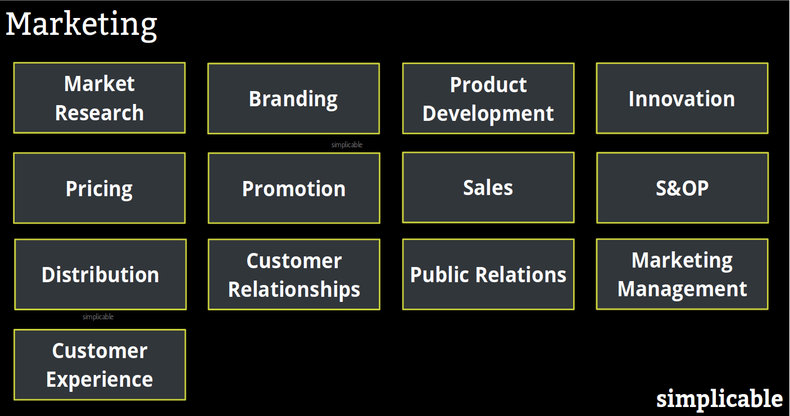

Market Research
The work of understanding customers, markets, competition and industry trends.Branding
Developing an identity for products and services that customers recognize and associate with a positive image and reputation.Product Development
Developing and improving products and services.Innovation
Product development that seeks leaps forward as opposed to gradual improvement.Pricing
Setting prices can be a surprisingly complex process. Pricing strategy may require extensive market research to keep an eye on your competition and the price sensitivities of your customers. It is common to use price discrimination strategies to try to charge customers according to their willingness to pay.Promotion
Communicating your brand and offers to customers. This includes the entire advertising industry and other types of promotion such as direct marketing and content marketing.Sales
The process of selling to the customer. Some organizations do little branding and promotion but rely on skilled sales people to sell their products and services.S&OP
Sales and operations planning is the process of aligning sales forecasts and production. For example, if you're going to spend money to generate demand for a shampoo product you want to make sure your factories are going to be able to meet that demand.Distribution
The process of reaching the customer to sell to them and to deliver your products and services. For example, a retailer with shops or an ecommerce company with a website.Customer Relationships
Managing relationships with customers to continue to sell to them. Managing customer relationships is also a key element of building a brand and product reputation.Public Relations
The process of managing your public image and reputation with all stakeholders including customers, employees, governments, communities and investors.Marketing Management
Directing, controlling, measuring and improving the marketing process. This can be broken into a large number of roles such as sales management, brand management and product management.Customer Experience
Marketing is often extended to include every interaction with the customer. For example, customer service and design are commonly considered marketing.Approaches to Marketing
Organizations and individuals take a variety of approaches to marketing including:
Production Orientation
Developing quality products and services and letting them "sell themselves" or relying on partners to do the selling.
Selling Orientation
A focus on personal selling. For example, a telecom company with a team of sales people who are good at closing deals may do little promotion or product development.
Relationship Orientation
Satisfying your existing customers to generate repeat business and word of mouth.
Marketing Orientation
Organizations that focus on every process above including product development, promotion, pricing, distribution, sales and customer experience.
| Overview: Marketing Definition | ||
Type | ||
Definition | The process of developing, delivering, communication and selling value. | |
Related Concepts | ||

































